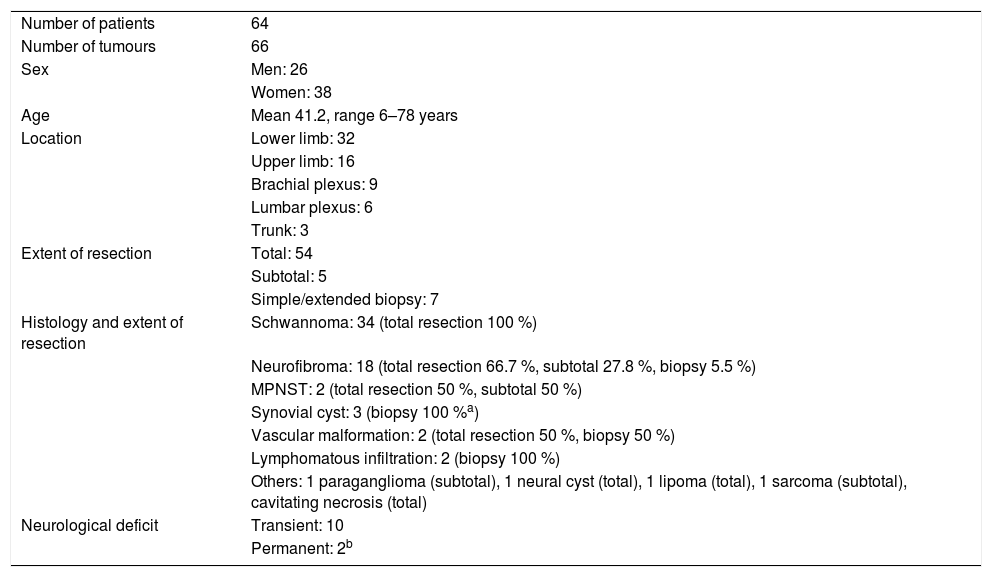Peripheral nerve tumours (PNT) are rare lesions that are generally categorised as soft tissue tumours, so they are usually managed by a range of surgical disciplines such as plastic, orthopaedic and trauma surgery, dermatology, general surgery and neurosurgery. Appropriate knowledge of the therapeutic indication and surgical management are essential in order to avoid neurological deficit.
Materials and methodsThis is a retrospective study of 66 tumour lesions in 64 patients, acquired from the joint experience of two surgical teams specialised in peripheral nerve surgery.
ResultsThe most common location was the lower limb and upper limb with 48 tumour lesions. The most common pathological diagnosis was Schwannoma, accounting for 51.5 %. Complete tumour resection was achieved in 81.8 % of the lesions and always with neurophysiological stimulation and/or monitoring. The most common postsurgical complication was neuropathic pain and/or a transient sensory disorder in 15 % of surgeries, with only one persistent motor deficit appearing in two cases that required nerve graft reconstruction.
ConclusionsAlthough the therapeutic management of benign tumours such as Schwannomas can be considered to be relatively simple thanks to the application of the basic concepts of peripheral nerve microsurgery, malignant tumors, despite being very rare, require multidisciplinary management. The option of pre-surgical biopsy remains a controversial issue and no consensus has been reached among the different authors. In our opinion, percutaneous biopsy is not necessary in most cases.
Los tumores de los nervios periféricos (TNP) son lesiones poco frecuentes que se categorizan en general dentro de los tumores de partes blandas, por lo que suelen ser manejados por diferentes disciplinas quirúrgicas como cirugía plástica, cirugía ortopédica y traumatológica, dermatología, cirugía general y neurocirugía. Un conocimiento apropiado en cuanto a la indicación terapéutica y el manejo quirúrgico son fundamentales de cara a evitar un déficit neurológico en el paciente.
Materiales y métodosEstudio restrospectivo donde se presenta la experiencia conjunta de dos equipos quirúrgicos especializados en la cirugía de los nervios periféricos, 66 lesiones tumorales, en un total de 64 pacientes.
ResultadosLa localización más frecuente fue el miembro inferior y miembro superior con 48 lesiones tumorales. El diagnóstico anatomopatológico más frecuente fue el de Schwannoma con un 51.5 %. La resección tumoral completa se logró en el 81.8 % de las lesiones y siempre con estimulación y/o monitorización neurofisiológica. La complicación postquirúrgica más frecuente fue el dolor neuropático y/o un trastorno sensitivo transitorio en el 15 % de las cirugías, apareciendo sólo un déficit motor persistente en dos casos que requirieron reconstrucción con injerto nervioso.
ConclusionesSi bien el manejo terapéutico de los tumores benignos como los Schwannomas puede considerarse relativamente sencillo aplicando los conceptos básicos en microcirugía de los nervios periféricos, los tumores malignos, si bien son muy infrecuentes, requieren de un manejo multidisciplinar. La opción de la biopsia prequirúrgica a día de hoy sigue siendo un tema controvertido y sin acuerdo entre los diferentes autores; en nuestra opinión no es necesaria su realización de forma percutánea en la mayoría de los casos.
Article

If it is the first time you have accessed you can obtain your credentials by contacting Elsevier Spain in suscripciones@elsevier.com or by calling our Customer Service at902 88 87 40 if you are calling from Spain or at +34 932 418 800 (from 9 to 18h., GMT + 1) if you are calling outside of Spain.
If you already have your login data, please click here .
If you have forgotten your password you can you can recover it by clicking here and selecting the option ¿I have forgotten my password¿.











